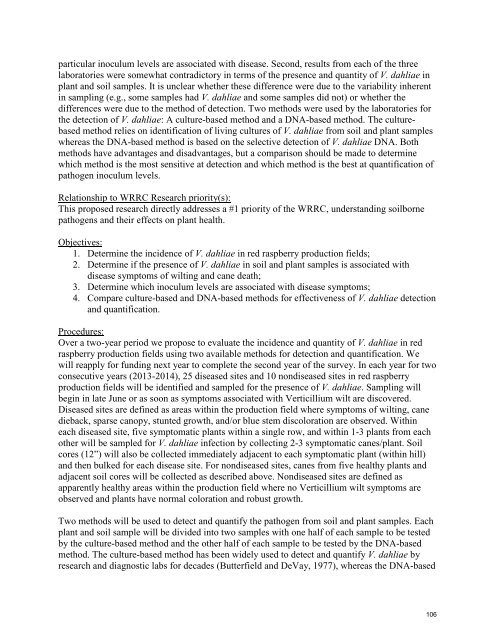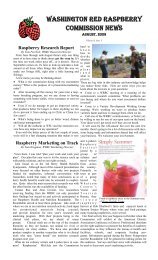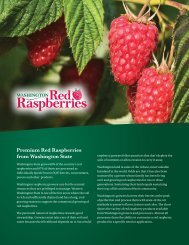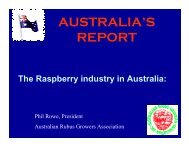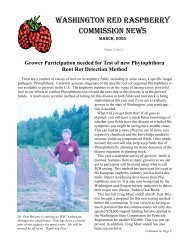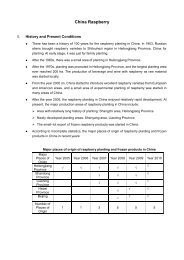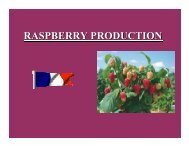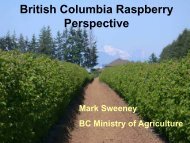2012 - Washington Red Raspberry Commission
2012 - Washington Red Raspberry Commission
2012 - Washington Red Raspberry Commission
You also want an ePaper? Increase the reach of your titles
YUMPU automatically turns print PDFs into web optimized ePapers that Google loves.
particular inoculum levels are associated with disease. Second, results from each of the three<br />
laboratories were somewhat contradictory in terms of the presence and quantity of V. dahliae in<br />
plant and soil samples. It is unclear whether these difference were due to the variability inherent<br />
in sampling (e.g., some samples had V. dahliae and some samples did not) or whether the<br />
differences were due to the method of detection. Two methods were used by the laboratories for<br />
the detection of V. dahliae: A culture-based method and a DNA-based method. The culturebased<br />
method relies on identification of living cultures of V. dahliae from soil and plant samples<br />
whereas the DNA-based method is based on the selective detection of V. dahliae DNA. Both<br />
methods have advantages and disadvantages, but a comparison should be made to determine<br />
which method is the most sensitive at detection and which method is the best at quantification of<br />
pathogen inoculum levels.<br />
Relationship to WRRC Research priority(s):<br />
This proposed research directly addresses a #1 priority of the WRRC, understanding soilborne<br />
pathogens and their effects on plant health.<br />
Objectives:<br />
1. Determine the incidence of V. dahliae in red raspberry production fields;<br />
2. Determine if the presence of V. dahliae in soil and plant samples is associated with<br />
disease symptoms of wilting and cane death;<br />
3. Determine which inoculum levels are associated with disease symptoms;<br />
4. Compare culture-based and DNA-based methods for effectiveness of V. dahliae detection<br />
and quantification.<br />
Procedures:<br />
Over a two-year period we propose to evaluate the incidence and quantity of V. dahliae in red<br />
raspberry production fields using two available methods for detection and quantification. We<br />
will reapply for funding next year to complete the second year of the survey. In each year for two<br />
consecutive years (2013-2014), 25 diseased sites and 10 nondiseased sites in red raspberry<br />
production fields will be identified and sampled for the presence of V. dahliae. Sampling will<br />
begin in late June or as soon as symptoms associated with Verticillium wilt are discovered.<br />
Diseased sites are defined as areas within the production field where symptoms of wilting, cane<br />
dieback, sparse canopy, stunted growth, and/or blue stem discoloration are observed. Within<br />
each diseased site, five symptomatic plants within a single row, and within 1-3 plants from each<br />
other will be sampled for V. dahliae infection by collecting 2-3 symptomatic canes/plant. Soil<br />
cores (12”) will also be collected immediately adjacent to each symptomatic plant (within hill)<br />
and then bulked for each disease site. For nondiseased sites, canes from five healthy plants and<br />
adjacent soil cores will be collected as described above. Nondiseased sites are defined as<br />
apparently healthy areas within the production field where no Verticillium wilt symptoms are<br />
observed and plants have normal coloration and robust growth.<br />
Two methods will be used to detect and quantify the pathogen from soil and plant samples. Each<br />
plant and soil sample will be divided into two samples with one half of each sample to be tested<br />
by the culture-based method and the other half of each sample to be tested by the DNA-based<br />
method. The culture-based method has been widely used to detect and quantify V. dahliae by<br />
research and diagnostic labs for decades (Butterfield and DeVay, 1977), whereas the DNA-based<br />
106


